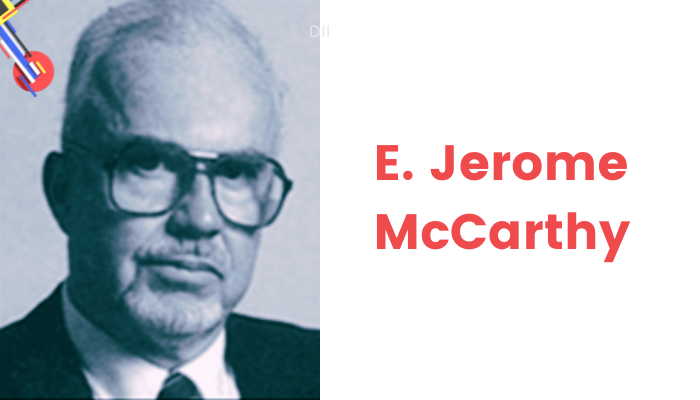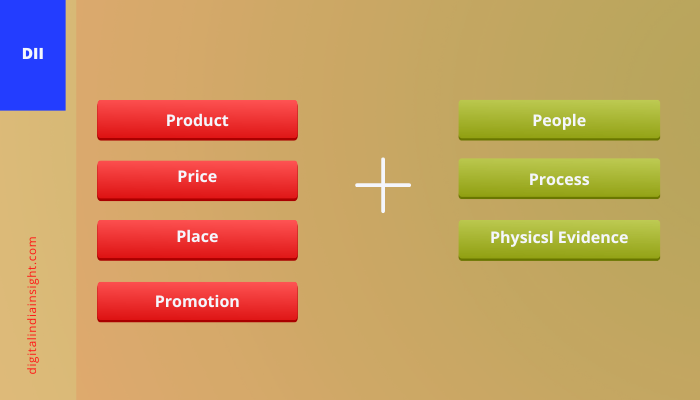Marketing is a strategic process to create and deliver value to your end customers. It’s the mix of the four most important activities that you strategize by understanding your customers’ needs and preferences. This is done by combining product development, pricing, distribution, and communication. In general, it can be said that it’s a combination of art and science to engage and satisfy your customer needs while achieving business success.
There are several marketing models are available that you can perform based on the type of business and its requirement. Here, we are going to discuss the Marking Ps.
Spending 5 minutes to learn about the 7 Ps of marketing will make you capable of building a better strategy for a successful business or your entrepreneurship journey.

Here, we will discuss this with examples and processes you can follow to enhance your marketing strategy for your business.
Before we dive into the details, let’s take a quick look at the history of the marketing mix.
The Marketing mix is a term popularized by E. Jerome McCarthy in the 1960s in his book Basic Marketing. Now, It is a tool used by businesses and brands to prepare a plan and execute the marketing strategy.
Keep reading, and you will know the difference between the 4 Ps and 7 Ps marketing mix.
What are the Seven Ps of marketing?
These are product, price, place, promotion, people, process, physical evidence, or simply the 7 Ps of the marketing mix. Let’s understand these first.
Product: It is what you sell to your customers. It could be the products or services. The product is the center of all the elements with the problem it solves, the benefits it offers, its features, etc.
Price: What do your customers want to pay for your product or services? What’s their view on your pricing?
Place: Where your ideal customers go to find the information about the product and make a purchase. It’s the target channel where you should promote your product or services.
Promotion: Promotion is informing your ideal customers about your product or services. Finding out the effectiveness of your promotion strategy helps plan your marketing approach.
People: It is a crucial element of the marketing mix. Because people can determine the experience of the customers using the products and services. People involved in delivering these goods or services come in this category. It could be anyone, your employee, friends, colleagues, or even existing or past customers.
Process: It shows the procedure and activity when the business and customers interact.
Physical Evidence: Physical evidence includes the company/business existence proof, such as your company’s website, logo, the place where the company exists and facilitates its service, customer reviews, pictures, and more. It shows evidence of the existence of the business.
Now, you have some understanding of the 7 Ps of the marketing mix. It’s easy to understand, but implementing it in actual cases is still a learning curve. Let’s learn more about these seven elements and how you can use them for the grand launch.
4 Ps Transformed to the 7 Ps of Marketing

The marketing mix concept came from Harvard Business School (America) by advertising professor Neil Borden, later known as the 4 Ps of the marketing mix. I have shared his monochromatic photograph for your reference right below.
He introduced the concept in the 1950s and showed how companies could use it to earn more consumers and profit. Companies are still using it, and an upgraded version, “the 7 Ps of Marketing,” is also present.
Don’t get confused between these two industry players, “Neil Borden and E. Jerome McCarthy.” You already know who introduced the marketing mix.
Professor E. Jerome McCarthy (Michigan State University) advanced the marketing mix and popularised it as a 4 Ps of Marketing Mix. Time flies, and he added three more elements and called them the 7Ps.
Ready to implement this? Remember, the marketing mix is not static; you should often evaluate the strategy and repeat it as you plan your business or product launch. The market is enormous, and the consumer base changes with the requirement and the products/services growth.

Now, let’s learn these with examples.
Product – The First P of Marketing Mix
The product is what you sell in the market. It could be the actual good or the service.
It could be a laptop, smartphone, or anything around the business that is available to purchase.
You can think of anything that is being offered by the business in exchange for profit. These are available to the customers to buy.
Scroll a little and learn how to find the right one that fits your goal and can thrive in the market.
Building a Product That Your Customers Love
You must find the right customers if you have the product to market. Give them what they want. Learn how they use the product and what problems it resolves. This information will help you upgrade your marketing strategy.
If you want to build the latest product, you are about to learn this art.
It’s simple — Get a great idea and share the stories about how you found this and how it is helping the people. Give a great deal and build loyalty. Of course, you have to research the market and find the right customers, time, and place. Do not forget to maintain the quality.
Still, the question “how to build a product?” is trouble. Let’s resolve it.
Ask people how you can help them. Do this by creating a poll.
There are multiple ways to do it. You can create a free poll with platforms Hotjar, SurveyMonkey, etc. All you have to do is, create a free account, compose questions, create a poll, and post/show it. You can link your website to collect visitor responses, mail the links to your email subscribers list, or post the survey link on social media.
Let’s see some ideas that you can ask to collect the response for creating a great product persona:
1. You can find out the problems users face in your niche by asking questions in your survey.
2. Find out what other alternatives to your products are available in the market. Your goal should be to find the responder’s favorite “your products alternative.” Knowing this lets you improve your product per the users’ expectations and improve the market.
3. Ask questions about the users’ likes and dislikes of the competitors’ products they use. That’s where the opportunities are.
4. If you are running a poll on your website, you can ask why they visited it and whether they found what they were looking for.
5. You should ask product improvement-related questions. You can improve your product quality or add extra features to hold your existing users and attract new users.
Think about all questions you can ask that relate to your niche.
Polls and surveys will save you a lot of time and effort. It is beneficial for both whether you have an existing product or want to develop a new one.
Price – The Second P of Marketing Mix
The 7 Ps of marketing is an important framework for businesses to consider when pricing their products and services.
The goods or service you sell has a price, and the right price can make you more profit. When it comes to pricing, the first step is to decide what product range you want to offer and how you want to position them in terms of quality and value. Consideration also needs to be given to how much people are willing to pay for your offering – this could be based on competitor offerings concerning features/benefits or brand recognition. Factors such as distribution networks (place) should also be considered when deciding prices.
Promotion – The Third P of Marketing Mix
Now let’s focus on the use of promotion under the 7 Ps of the marketing mix.
Promotion is an essential element of the 7Ps as it helps to boost sales and encourage consumer engagement with a product or service. Promotional activities can include direct mail campaigns, email marketing campaigns and traditional advertising such as television commercials or print ads. It’s also important to consider digital promotional activities such as social media advertising and content marketing to maximize reach and effectiveness. Additionally, promotions can be designed through loyalty programs or special offers to reward customers for their loyalty or incentivize them to purchase more products or services from your business.
To determine the best approach for your business, consider the following questions:
- Who is your target audience?
- What are the key benefits of your product or service?
- What are your goals for the promotion?
- What budget do you have available for promotion marketing?
Based on your answers to these questions, you can determine the right mix of promotion tactics to use. For example, if you have a limited budget and are targeting a specific group of consumers, you may want to focus on targeted advertising or personal selling. If you have a larger budget and want to reach a broader audience, use a combination of tactics, such as advertising, public relations, and sales promotions.
Place – The Fourth P of Marketing Mix
When creating a successful marketing campaign, understanding the marketing mix is essential.
Firstly, think about the geographical reach you want to achieve with your product or service. If needed, consider expanding into new regions and countries if there’s potential for growth in those areas. Secondly, understand what channels you should use when delivering your product or service, whether through brick-and-mortar stores, online retailers or third-party services like Amazon FBA. Finally, ensure that you have enough stock available so that customers always have access to what they need when they need it – this will help keep them coming back for more!
To use the place element of the marketing mix, you will need to consider the following factors:
- Who is your target audience?
- What channels do your customers typically use to purchase products or services like yours?
- What is the geographic location of your target market?
- What is the availability of your product or service in the market?
Based on your answers to these questions, you can develop a place strategy that meets the needs of your target audience and ensures that your product or service is available in the right place at the right time. For example, if you are targeting a national audience, you may want to use a combination of online and offline distribution channels to make your product available in different regions. Alternatively, if you are targeting a local market, you should focus on local media, such as brick-and-mortar stores or online marketplaces.
People – The Fifth P of Marketing Mix
People are the fifth and arguably one of the most important of the 7 Ps of Marketing Mix. Serving customers right is crucial in determining how successful a business can be. Staff must be trained to provide excellent customer service, as this will create trust between them and their customers, which is essential for any organization.
It’s important to remember that People form an integral part of any marketing mix. A company must ensure its reputation remains intact and its workforce has the skills, knowledge, confidence, and enthusiasm necessary for success. By investing in employee training programs, businesses can provide excellent customer service and build positive relationships with clients, increasing sales revenue over time.
Let’s make this clear; do this…
1. Build strong relationships with your customers,
2. Leverage word-of-mouth marketing and encourage customers to share their experiences with others.
Process – The Sixth P of Marketing Mix
A prominent business coach, Brian Tracy, defines “process” as “how marketing activities are conducted”.
The process is an integral part of ensuring success in any marketing situation. It involves taking time to understand the customer journey and create systems that respond quickly and effectively to customer needs. When implemented correctly, it can make your marketing activities more efficient; for example, by reducing costs associated with running campaigns. It can also help you keep track of customer engagement and identify areas where improvement is needed.
To effectively use the “Process” element of the marketing mix, a company should focus on streamlining its production and delivery processes to improve efficiency, reduce costs, and enhance the customer experience. You can use new technologies or production methods, implement quality control measures, or find ways to make the delivery process more convenient and efficient for customers.
Also Read: Basic Guide to Start a Business in India
Physical Evidence: The Seventh P of Marketing Mix
Physical evidence can be the design and layout of a store, the appearance of a product or packaging, or the cleanliness and overall atmosphere of a restaurant or service environment.
When you purchase something online and receive the package in good condition, this is physical evidence that suggests your purchase was worth it.
Customers who interact with your business will form impressions based on their experiences with physical objects such as products, promotional materials, and even stores. Therefore, companies must ensure that all physical evidence associated with their brand offers an experience that accurately reflects its messaging and values.
Brands should pay attention to packaging design and store ambiance to create pleasant customer experiences. Ultimately, this will help them build trust with their target audience.
